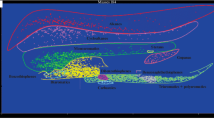Summary
We have used capillary gas chromatography/mass spectrometry to characterize extracts of Posidonomia shales and of fossil wood (gagat) found in these shales.
Samples were obtained from Dotternhausen oil shale formation (FRG) belonging to LIAS-epsilon (Toarcien).
Identified components are n-alkanes (C7 to C27), isoprenoid hydrocarbons (like pristane and phytane) and cycloalkanes with 6 to 9 carbon atoms. Aromatic hydrocarbons were also found in the low boiling fraction of extracts of fossil wood.
To obtain more detailed information about genesis and maturity of the Dotternhausen sediments we also applied Cross Polarisation Magic Angle Spin-13C-Nuclear Magnetic Resonance (CP/MAS-13C-NMR) spectroscopy. We compared the solid state spectra of fossil wood out of Posidonomia shales with the solid state13C-NMR-spectra of humic substances of different age and different origin. We found that the solid state spectra of humic substances of increasing age and the solid state spectra of fossil wood show striking similarity.
The results are discussed with respect to the maturity of the Dotternhausen sediments and the genesis of fossil fuels where humic substances may act as intermediates.
Similar content being viewed by others
References
L.V.S. Hook, C.M. Erikson, in “Recent Advances in Capillary Gas Chromatography”, Volume 2,W. Berisch, W.G. Jennings, R.E. Kaiser, eds. Hüthig, Heidelberg, 1982; p. 269–280.
P. Albrecht, G. Ourisson, Angew. Chem.83, 221 (1971).
G. Ourisson, P. Albrecht, M. Rohmer, Scientific American251, 34 (1984).
W. Heller, M. Schallies, K. Schmidt, J. Chromatogr.186, 843 (1979).
L. W. Dennis, G. E. Maciel, P. G. Hatcher, B. R. T. Simoneit, Geochim. Cosmochim. Acta46, 901 (1982).
D. W. Jones, Trends Anal. Chem.2, 83 (1983);K. D. Bartle, D. W. Jones, Trends Anal. Chem.2, 140 (1983).
W. Bergmann, A. R. Hernanto, W. Heller, M. Schallies, in “Origins of Life”, 14, D. Reidel Publishing Company, Dordrecht, 1984; p. 69–74
E. Bayer, K. Albert, W. Bergmann, K. Jahns, W. Eisener, H. K. Peters, Angew. Chem.96, 151 (1984). Angew. Chem. Int. Ed. Engl.23, 147 (1984).
A. R. Palmer, G. E. Maciel, Anal. Chem.54, 2194 (1982).
D.H. Welte, in “Advances in Organic Chemistry 1973”, Editions Technip, Paris, 1974; p. 3–13
B. P. Tissot, D. H. Welte, “Petroleum Formation and Occurrence”, Springer, Berlin, 1984.
Author information
Authors and Affiliations
Rights and permissions
About this article
Cite this article
Bergmann, W., Heller, W., Hernanto, A.R. et al. Posidonomia shales (FRG) and their relation to humic substances. Chromatographia 19, 165–169 (1984). https://doi.org/10.1007/BF02687733
Received:
Accepted:
Issue Date:
DOI: https://doi.org/10.1007/BF02687733




